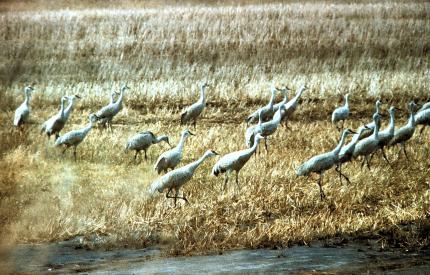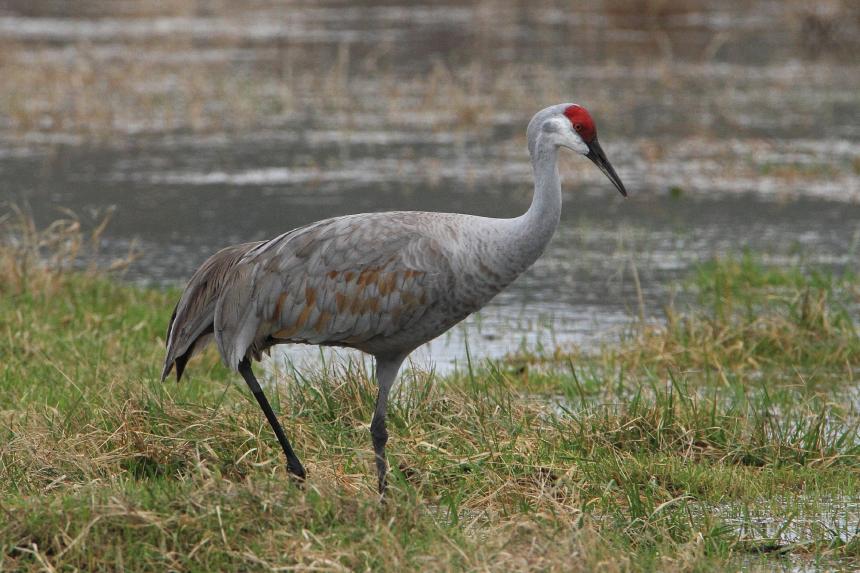The Washington population of greater sandhill cranes is critical but the trend is increasing; they number about 100 adult and subadult birds, with about 40 breeding pairs. Three subspecies of sandhill crane occur in Washington—greater, lesser and Canadian. WDFW has listed all as state endangered.
Description and Range
Physical description
Adult sandhill cranes are primarily gray in color and have a reddish cap. Subadults have a pale rust-colored head and neck; their body is gray, overlaid with a mottled rust-color. Adults are about 3½ feet in length, and their wingspan is a little over 6 feet across.
Ecology and life history
Sandhill cranes are long-lived, but have a low reproductive rate, and their nests are vulnerable to predators, disturbance, and fluctuating water levels.

Breeding territories contain wetlands, grassy uplands, partially forested uplands, and wet meadows, and are sometimes surrounded by forest. Sandhill cranes nest in wet meadows and grasslands. Emergent vegetation is a key component of their preferred nesting areas. Nests, which are built in emergent vegetation in shallow water or close to water, are a mound of plant material pulled up from around the site and anchored to surrounding vegetation.
During migration and in winter they live in more open grassland and river valleys, and often feed in agricultural fields. Sandhill cranes typically use habitats where they have clear views of their surroundings.
Sandhill cranes eat insects, rodents, snails, small reptiles, amphibians, nestling birds, the roots of aquatic plants, tubers, berries, seeds, and grains. During migration they often feed on waste grains, particularly rice and corn, but also milo, wheat, oats, and barley. The Columbia Basin and lower Columbia River bottomlands are very important staging areas for cranes for 'refueling' during migration.
The courtship of cranes includes elaborate rituals, and birds often mate for life. Pairs return to the same nesting territories year after year and sometimes use the same nest repeatedly. The young learn migratory routes from adults, and Washington birds migrate to the Central Valley of California.
Geographic range
The greater sandhill crane formerly nested at numerous sites throughout eastern Washington, and it was extirpated for about 30 years.
Between 1975 and 1987, a single pair of sandhill cranes nested at Conboy Lake NWR in Klickitat County. Since 1988, 2 to 6 pairs/year are known to have nested on the refuge, and in 1996 there were 9 confirmed breeding pairs. Nesting cranes were discovered at a second site in Washington on the Yakama Indian Reservation in Yakima County, where 1 pair nested in 1994 and 1995, and 2 pairs nested in 1996.
Greater sandhill cranes currently breed at about six locations in Klickitat and Yakima Counties. The breeding population in Washington numbers only about 40 pairs but has been slowly increasing.
Breeding sandhill cranes arrive at Conboy Lake National Wildlife Refuge in early March. Most nesting occurs from April to June, though a newly hatched "colt" (a crane chick) has been observed as late as early July. Breeding cranes and their surviving young leave the state between late September and mid-October. These cranes are part of the Central Valley Population that winter in California's Central Valley.
Climate vulnerability
Sensitivity to climate change
Moderate
Sandhill cranes require wetlands for nesting and some feeding, and prefer open water with little emergent vegetation for roosting. They are sensitive to drought, low flows, or flooding that decrease available nesting, foraging, or roosting habitat. Sandhill cranes appear to have low physiological sensitivity to changes in climate, but little information currently exists on this topic.
Exposure to climate change
Moderate
- Drought
- Altered hydrology
Conservation
Conservation Threats and Actions Needed
- Resource information collection needs
- Threat: Inadequate information to manage small population.
- Action Needed: Aerial surveys of nesting territories; information about new territories.
- Threat: Assess survival, recruitment.
- Action Needed: Analysis of banding data to assess recruitment/survival.
- Agriculture and aquaculture side effects
- Threat: Nests are vulnerable to water-level changes.
- Action Needed: Enhance effectiveness of water management.
See the Climate vulnerability section for information about the threats posed by climate change to this species.
Resources
References
Littlefield, C. D., and G. L. Ivey. 2002. Washington State Recovery Plan for the Sandhill Crane. Washington Department of Fish and Wildlife, Olympia, Washington.
Tacha, T. C., S. A. Nesbitt, and P. A. Vohs. 1992. Sandhill crane (Grus canadensis tabida). Birds of North America 31: 1-24..
WDFW publications
PHS Program


